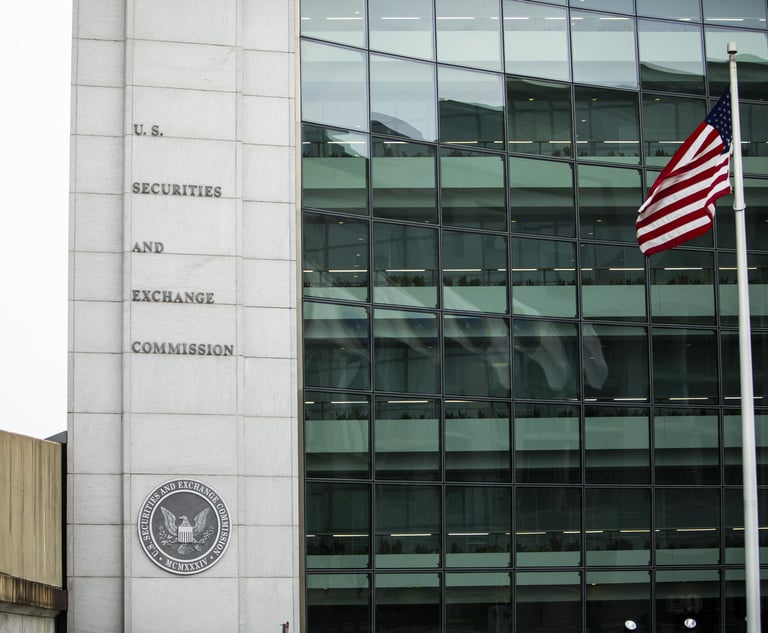IP: Certain trade secrets are now exempt from patent infringement
A new law expands prior commercial use defense.
November 01, 2011 at 06:45 AM
3 minute read
The original version of this story was published on Law.com
The recently enacted Leahy-Smith America Invents Act expands the “prior commercial use” defense to patent infringement in order to benefit companies choosing to keep key technologies used in manufacturing and other commercial processes as trade secrets instead of protecting them with patents.
Although the defense cannot be used to invalidate a patent, it can prevent a new patentee from interfering in the continued practice of a technology developed well before the patentee invented it. Previously, the “commercial use” defense could only be asserted against business method patents.
Effective Sept. 16, 2011, any patent issued on or after that date is subject to the defense that an alleged infringer “commercially used” the subject matter of the patent in the U.S. more than one year prior to the earlier of the filing date of the patent or the date the claimed invention was publicly disclosed.The expanded defense covers all patent-eligible subject matter used in a manufacturing or other commercial process.
The Act expands the definition of “commercial use” to include:
- Premarketing regulatory review, when the safety or efficacy of the subject matter is established
- Use by a nonprofit entity whose intended beneficiary is the public
Commercially used, abandoned and then used again technology cannot claim the benefit of the earlier use.
Also, there is a significant “University Exception”: the defense does not apply if the patented invention was “made, owned or subject to an obligation of assignment to an institution of higher education” or to an affiliated technology transfer organization. Thus, if the technology is in a field where university research is active, it remains subject to potential jeopardy.
Although the defense is personal to the entity that performed or directed performance of the “commercial use,” it may also be asserted by any entity that controls, is controlled by or under common control with the original entity. The defense is also transferable as part of a good-faith transfer with the whole line of business to which the defense relates.
Proving the defense will necessarily depend upon accurate record-keeping. For a technology commercially used in secret, the key will be to document the dates of use and the technical details of the technology actually used. If the technology evolves over time, updated records will be needed to protect the new iterations.
Given a patent damages window extending six years back in time, but not before the issue date of the patent, the retention period for those records should be carefully adjusted based on the particular circumstances.
This content has been archived. It is available through our partners, LexisNexis® and Bloomberg Law.
To view this content, please continue to their sites.
Not a Lexis Subscriber?
Subscribe Now
Not a Bloomberg Law Subscriber?
Subscribe Now
NOT FOR REPRINT
© 2025 ALM Global, LLC, All Rights Reserved. Request academic re-use from www.copyright.com. All other uses, submit a request to [email protected]. For more information visit Asset & Logo Licensing.
You Might Like
View All
Internal Whistleblowing Surged Globally in 2024, So Why Were US Numbers Flat?
6 minute read
FTC Finalizes Child Online Privacy Rule Updates, But Ferguson Eyes Further Changes
Trending Stories
- 1Class Action Litigator Tapped to Lead Shook, Hardy & Bacon's Houston Office
- 2Arizona Supreme Court Presses Pause on KPMG's Bid to Deliver Legal Services
- 3Bill Would Consolidate Antitrust Enforcement Under DOJ
- 4Cornell Tech Expands Law, Technology and Entrepreneurship Masters of Law Program to Part Time Format
- 5Divided Eighth Circuit Sides With GE's Timely Removal of Indemnification Action to Federal Court
Who Got The Work
J. Brugh Lower of Gibbons has entered an appearance for industrial equipment supplier Devco Corporation in a pending trademark infringement lawsuit. The suit, accusing the defendant of selling knock-off Graco products, was filed Dec. 18 in New Jersey District Court by Rivkin Radler on behalf of Graco Inc. and Graco Minnesota. The case, assigned to U.S. District Judge Zahid N. Quraishi, is 3:24-cv-11294, Graco Inc. et al v. Devco Corporation.
Who Got The Work
Rebecca Maller-Stein and Kent A. Yalowitz of Arnold & Porter Kaye Scholer have entered their appearances for Hanaco Venture Capital and its executives, Lior Prosor and David Frankel, in a pending securities lawsuit. The action, filed on Dec. 24 in New York Southern District Court by Zell, Aron & Co. on behalf of Goldeneye Advisors, accuses the defendants of negligently and fraudulently managing the plaintiff's $1 million investment. The case, assigned to U.S. District Judge Vernon S. Broderick, is 1:24-cv-09918, Goldeneye Advisors, LLC v. Hanaco Venture Capital, Ltd. et al.
Who Got The Work
Attorneys from A&O Shearman has stepped in as defense counsel for Toronto-Dominion Bank and other defendants in a pending securities class action. The suit, filed Dec. 11 in New York Southern District Court by Bleichmar Fonti & Auld, accuses the defendants of concealing the bank's 'pervasive' deficiencies in regards to its compliance with the Bank Secrecy Act and the quality of its anti-money laundering controls. The case, assigned to U.S. District Judge Arun Subramanian, is 1:24-cv-09445, Gonzalez v. The Toronto-Dominion Bank et al.
Who Got The Work
Crown Castle International, a Pennsylvania company providing shared communications infrastructure, has turned to Luke D. Wolf of Gordon Rees Scully Mansukhani to fend off a pending breach-of-contract lawsuit. The court action, filed Nov. 25 in Michigan Eastern District Court by Hooper Hathaway PC on behalf of The Town Residences LLC, accuses Crown Castle of failing to transfer approximately $30,000 in utility payments from T-Mobile in breach of a roof-top lease and assignment agreement. The case, assigned to U.S. District Judge Susan K. Declercq, is 2:24-cv-13131, The Town Residences LLC v. T-Mobile US, Inc. et al.
Who Got The Work
Wilfred P. Coronato and Daniel M. Schwartz of McCarter & English have stepped in as defense counsel to Electrolux Home Products Inc. in a pending product liability lawsuit. The court action, filed Nov. 26 in New York Eastern District Court by Poulos Lopiccolo PC and Nagel Rice LLP on behalf of David Stern, alleges that the defendant's refrigerators’ drawers and shelving repeatedly break and fall apart within months after purchase. The case, assigned to U.S. District Judge Joan M. Azrack, is 2:24-cv-08204, Stern v. Electrolux Home Products, Inc.
Featured Firms
Law Offices of Gary Martin Hays & Associates, P.C.
(470) 294-1674
Law Offices of Mark E. Salomone
(857) 444-6468
Smith & Hassler
(713) 739-1250








